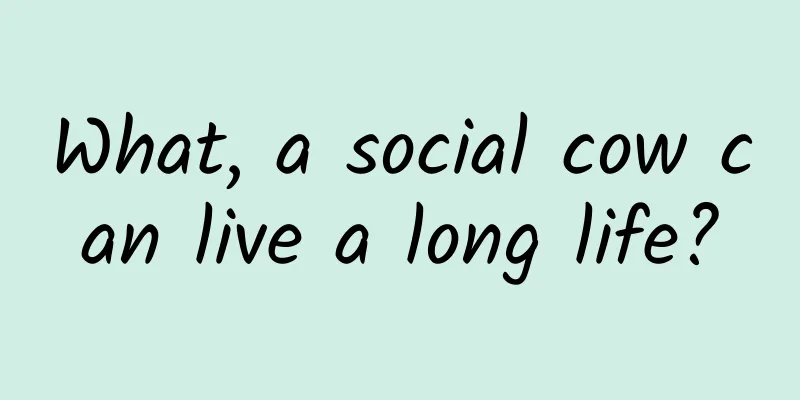What, a social cow can live a long life?

|
Produced by: Science Popularization China Author: Bingbingbang (Institute of Zoology, Chinese Academy of Sciences) Producer: China Science Expo Are you socially anxious? After hearing this question, many people may nod their heads in agreement. In our daily lives, when we say "I am socially anxious", most of the time we mean: I am not so good at socializing or I am afraid of communicating with strangers. But in fact, solitary animals are more "socially anxious" than social animals like humans. Recently, Professor Zhou Xuming's team from the Institute of Zoology, Chinese Academy of Sciences, published a new study: sociality may have a direct relationship with lifespan. (Photo source: Veer Gallery) When necessary, "holding thighs" is actually the secret to longevity In this study, researchers conducted statistical analysis and explored the deep molecular mechanisms involved in the relationship between the social organization status of about 1,000 species of mammals (divided into three different social organization states: solitary, pair living, and group living) and their lifespan. The results calculated by Bayesian statistical methods show that in the long process of biological evolution, social species usually have longer lifespans than solitary species. And for social species, the speed at which they evolve from a short-lived state to a long-lived state is higher than that of non-social species. These results all show that the state of social organization is highly correlated with the evolution of its lifespan. In other words, in the process of evolution, social animals have far surpassed non-social animals in terms of lifespan alone. In fact, we can roughly analyze the reasons why social species can live long. First of all, it must be mutual help among the population. The reason why social species live long may be that the social life form allows those individuals who are not capable enough to catch food to have food with the help of their companions. Holding on to the "thighs" of the strong, it is not easy to starve to death, thus reducing the mortality rate of the entire group. In addition, animals living in groups will form some special intimate relationships, such as spouse relationships, parent-offspring kinship, etc. This intimate relationship enables them to form a better invisible alliance, strengthen mutual assistance in the growth and reproduction process, further improve the health of individual animals and the survival rate of their offspring, all of which make the overall lifespan of social species tend to be extended. Penguins are social animals (Photo source: veer) In order to survive, species in nature have evolved "selfish" genes. However, various emotional connections sometimes make them willing to give up some of their own survival resources or interests in order to achieve the prosperity of the entire population. This does give us a lot to think about. However, group living is certainly not without disadvantages. Group living will cause greater competition pressure for individual animals due to competing for mates and food, and increase the probability of the spread of infectious diseases. But compared with the benefits of group living, these unfavorable cost factors can be almost ignored. Sure enough, no matter where you are, no matter what species you are, even if you can sometimes "cling to someone powerful", you still cannot avoid the "peer pressure" of survival. Molecular analysis of the close relationship between health status and social interaction So, besides reducing the probability of individual death through mutual help among individuals, does group living have any impact on the health status of the individuals themselves? In fact, there have been relevant studies on the relationship between social interaction and individual health. For example, patients with depression are more likely to have low immunity and suicidal tendencies, which are not conducive to individual health and survival. However, there is still no unified conclusion on the correlation between social interaction and life expectancy. To explain this problem, Professor Zhou Xuming's team extracted brain tissue from 94 mammals and measured transcriptome data. By comparing and analyzing the transcriptome data of each species, 31 genes, hormones, and immune-related pathways were identified. The research team found that group living is also related to the health status of individuals, which lays the foundation for the molecular mechanism of the impact of social organization on life span. This molecular level of correlation has also been shown in other studies. For example, long-tailed macaques (Macaca fascicularis) build a high degree of kinship among each other when they live in groups, which enhances the immune system of individuals in the group. On the contrary, social isolation or limited social contact can induce neuroendocrine regulation, causing a large accumulation of inflammation in the body and impairing immune function. Long-tailed macaque (Photo source: veer) Living in groups is not just about helping each other, it also affects the species' immune system, and thus the health of individuals. In fact, it is not just social interaction that affects individual health, but also the individual's health that affects their social behavior. So if we can improve the individual's health, the individual will tend to show friendlier social behavior. For example, in mice, interleukin can directly act on mice with social deficits and restore their social abilities. This is understandable, because hormones in organisms have a variety of regulatory effects and affect various behaviors of individuals, so hormone regulation is also related to social organization and longevity. For example, reducing the signaling of insulin-like growth factor 1 has been shown to extend the lifespan of mice, fruit flies, yeast and worms. Steroid hormones (such as testosterone, estradiol and progesterone) also regulate a series of social behaviors, including mating behavior, aggression, grooming behavior and paternal behavior. (Photo source: Veer Gallery) Conclusion Professor Zhou Xuming's team used the life span of nearly 1,000 species and their preferences for social organization to explain the relationship between social interaction and individual health. It can be seen that necessary social interaction is essential for the healthy growth, survival and reproduction of individuals. Therefore, from the perspective of physical and mental health, everyone can open their hearts and interact more with family and friends. However, everyone has different preferred social distances. Although research tells us that socializing is good for physical health, the best one is the one that suits you. References: [1] https://www.nature.com/articles/s41467-023-35869-7 Editor: Guo Yaxin (Note: Latin text should be italicized.) |
<<: I just realized that Chinese people drink hot water to “save lives”!
>>: Fortunately, there are still Mogao Grottoes in the world
Recommend
Lanzhou WeChat used car mini program function, how much does it cost to develop a used car trading mini program?
With the rise of "new energy" vehicles, ...
Now that both black boxes have been found, can we recover the truth? Why isn't the data transmitted back to the ground in real time?
Experts in this article: Liu Yuxuan, Tianjin Fore...
7 directions for optimizing medical bidding plans!
The SEM bidding promotion team concluded that a g...
Produced by experts from a big company: You will definitely not be able to tell the difference between these two Apple controls!
Hello, I didn’t expect the new year to be over so...
Did you know? The mobile phone is 46 years old
Remember your first mobile phone? Xiaolingtong? C...
How to write a crisis public relations plan?
Introduction: Behind every event, there is a trut...
In information flow promotion, how can you let users quickly understand your product? Just 2 steps!
When users are unable to fully understand the pro...
15 sales secrets to achieve 100% conversion rate, how to ask questions to dig deep into needs
15 Sales Secrets for 100% Conversion Rate Resourc...
The world's first "gar" is in Yunnan? The ancestor of the water's little tyrant has been discovered
The gar, which now lives in the freshwater enviro...
Inventory: Five regular and long-term side projects that can make money at home
Today’s content is a bit too much, the full text ...
Unmanned retail stores look great, but the so-called low cost is not true?
Unmanned convenience stores in Shanghai, Hangzhou...
Qutoutiao advertising cases and advertising forms, advertising effects!
The editor will introduce to you the advertising ...
Yuzu Investment Classroom Series Courses (Third Phase + Fourth Phase + Fifth Phase + Sixth Phase + Highlights Edition)
Resource introduction of the Yuzu Investment Clas...
After studying 10 big Douyin accounts, I found 8 Douyin promotion routines
Brother Xian has been feeling rather depressed la...
In 2020, mobile phone manufacturers will not be able to wait for the 5G trend
In the mobile phone industry, the following judgm...









